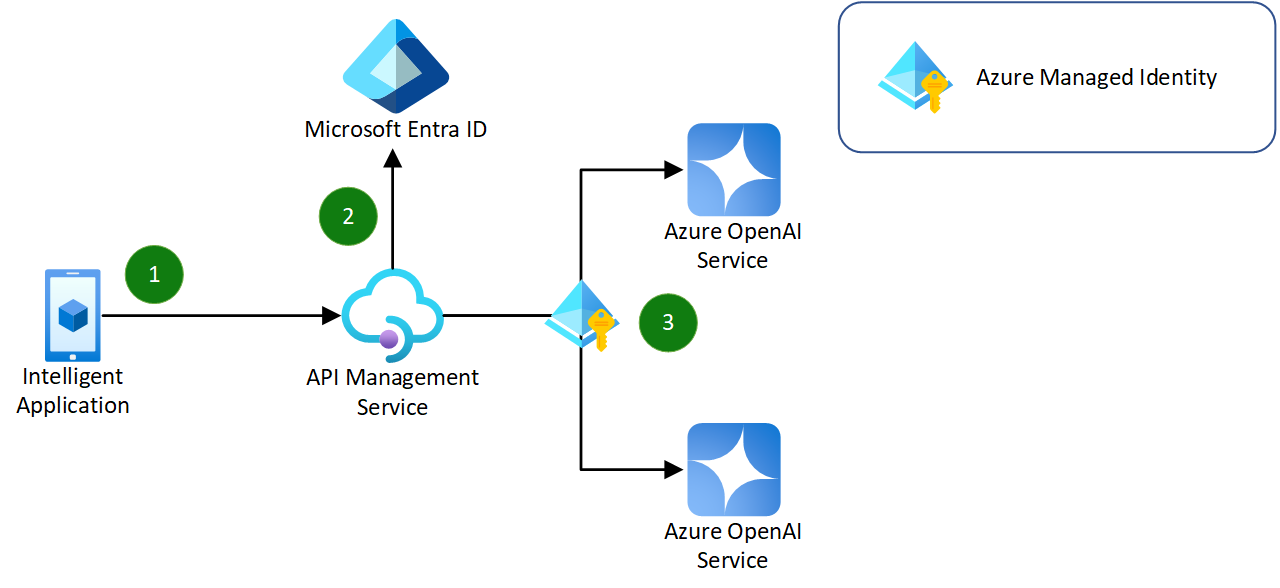| page_type | languages | products | name | description | |||||||||
|---|---|---|---|---|---|---|---|---|---|---|---|---|---|
sample |
|
|
Azure OpenAI Service Load Balancing with Azure API Management |
This sample demonstrates how to load balance requests between multiple Azure OpenAI Services using Azure API Management. |
This sample demonstrates how to use Azure API Management to load balance requests to multiple instances of the Azure OpenAI Service.
This approach takes advantages of the static, round-robin load balancing technique using policies in Azure API Management. This approach provides the following advantages:
- Support for multiple Azure OpenAI Service deployments behind a single Azure API Management endpoint.
- Remove complexity from application code for managing multiple Azure OpenAI Service instances and their authentication mechanisms using Azure API Management with policies and managed identity.
- Retry logic for failed requests between Azure OpenAI Service instances.
For more information on topics covered in this sample, refer to the following documentation:
- Understand policies in Azure API Management
- Error handling in Azure API Management policies
- How to configure Azure OpenAI Service with managed identities
The following diagram illustrates the simplified flow of the sample.
- A user makes a request to a deployed Azure API Management API that is configured using the Azure OpenAI API specification.
- The API Management API is configured with a policy that uses a static, round-robin load balancing technique to route requests to one of the Azure OpenAI Service instances.
- A bearer token is generated using the managed identity associated with the Azure API Management instance which has the Cognitive Services OpenAI User role assigned to the Azure OpenAI Service instances.
- The original request including headers and body are forwarded to the selected Azure OpenAI Service instance, along with the Authorization header containing the bearer token.
If the request fails, the policy will retry the request with the next Azure OpenAI Service instance, and repeat in a round-robin fashion until the request succeeds or a maximum of 3 attempts is reached.
- Azure OpenAI Service, a managed service for OpenAI GPT models that exposes a REST API.
- Azure API Management, a managed service that provides a gateway to the backend Azure OpenAI Service instances.
- Azure Managed Identity, a user-defined managed identity for Azure API Management to authenticate with Azure OpenAI.
- Azure Bicep, used to create a repeatable infrastructure deployment for the Azure resources.
To deploy the infrastructure and test load balancing using Azure API Management, you need to:
- Install the latest .NET SDK.
- Install PowerShell Core.
- Install the Azure CLI.
- Install Visual Studio Code with the Polyglot Notebooks extension.
- Apply for access to the Azure OpenAI Service.
The Sample.ipynb notebook contains all the necessary steps to deploy the infrastructure using Azure Bicep, and make requests to the deployed Azure API Management API to test load balancing between two Azure OpenAI Service instances.
Note: The sample uses the Azure CLI to deploy the infrastructure from the main.bicep file, and PowerShell commands to test the deployed APIs.
The notebook is split into multiple parts including:
- Login to Azure and set the default subscription.
- Deploy the Azure resources using Azure Bicep.
- Test load balancing using Azure API Management.
- Cleanup the Azure resources.
Each step is documented in the notebook with additional information and links to relevant documentation.
